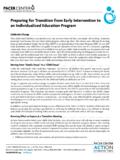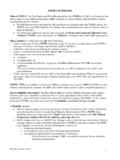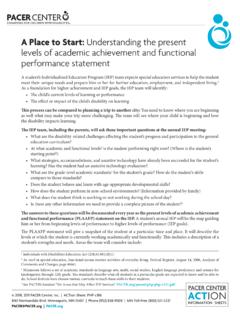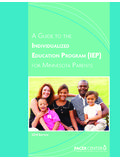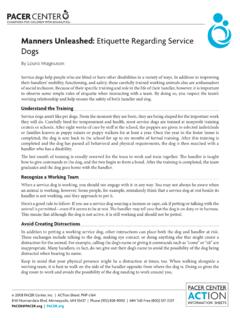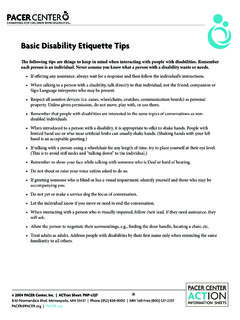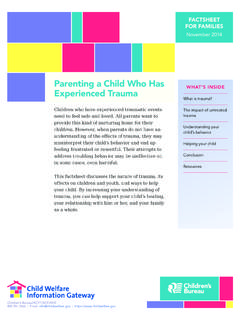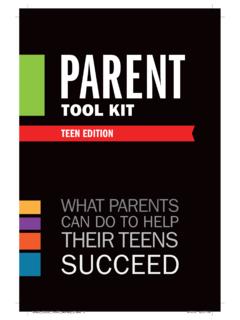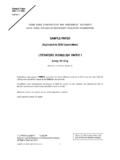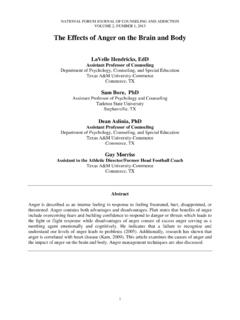Transcription of What if Your Child IS the One Showing Bullying …
1 2015, 2005, PACER Center, Inc. | ACTion Sheet: PHP-c1098161 Normandale Blvd. Minneapolis, MN 55437 | Phone (952) 838-9000 | MN Toll-Free (800) | CENTERACTIONINFORMATION SHEETSWhat if your Child IS the One Showing Bullying Behavior?The word Bullying often conjures up an image of a schoolyard scene, with a big, intimidating student towering over a small, cowering Child . However, that s just one of the many faces of children who bully. Another face of someone who bullies might be that of your own Child . Surprised? Many parents are.
2 Often they have no idea that their Child is Bullying other children. Yet recognizing the situations and acting to change the behavior is vitally important in making the future safer for your Child and all s why. Children who bully can be affected as much as those they target. Statistically, they are significantly more likely than others to experience school failure, depression, violence, crime, and other problems. The message is clear: Bullying is too important to your Child be Bullying others? Would you know? Once you found out, would you know what to do?
3 Here is some information that can is Bullying ? Bullying is different from the routine conflicts of childhood. It is intentional behavior that is meant to hurt and dominate another person. Characterized by an imbalance of power between the Child who bullies and the target, Bullying can be physical, verbal, emotional (social), or sexual. It includes harassment using technology, such as texts, email, and social media. Bully versus Child who bullies The language used when referring to Bullying behavior is important as it influences how students involved in Bullying situations are perceived.
4 Bullying is about behavior. Instead of labeling a Child as a bully, consider using the terms Child who bullies or a Child with Bullying behavior, which recognizes that they are first and foremost a Child and second that they have exhibited a specific behavior. Children with Bullying behavior should be provided with consequences and discipline that allow them the opportunity to redirect their behavior in more positive ways as behavior can be who does it?Think the person Bullying is the big guy who wears black, has low self-esteem, and gets mad a lot?
5 Could be, but it can also be the petite cheerleader or the quiet honor student. It s not appearance that defines someone who bullies; it is behavior. They can come from any background, race, income level, family situation, gender, or religion. Research has shown that despite their differences, children who bully typically have one or more of the following traits. They may: Be quick to blame others and unwilling to accept responsibility for their actions Lack empathy, compassion, and understanding for others feelings Be bullied themselves Have undeveloped social skills Want to be in control Be frustrated, anxious, or depressed Find themselves trying to fit in with a peer group that encourages Bullying 2015, 2005 PACER Center, Inc.
6 | ACTion Sheet: PHP-c109 | you see these traits in your Child or hear from others that your Child is Bullying , it s important to look into the issue. If you do discover that your Child is Bullying , take heart. Bullying is a learned behavior and it can be unlearned and replaced with more positive behaviors. By talking with your Child and seeking help, you can teach your Child more appropriate ways of handling feelings, peer pressure, and conflicts. Here are some your Child to stop Bullying Talk with your Child . Children may not always recognize their behavior as Bullying .
7 They may see it as just having fun and not realize the impact it has on another Child . Help them understand what defines Bullying and emphasize that negative behavior is not reasons for the out why your Child is behaving in a manner that is harmful to others through an open, non-judgmental discussion. You might ask your Child how he or she is feeling, if he or she is being bullied by someone else, or if your Child is experiencing peer pressure from friends who are also that your Child s behavior is Bullying and not the result of a disability.
8 Sometimes, children with disabilities who have certain emotional and behavioral disorders or limited social skills act in ways that are mistaken for Bullying . Whether the behavior is intentional or due to a disability, it still needs to be addressed. If your Child with a disability is Bullying , you may want to include Bullying prevention goals in his or her Individualized Education Program (IEP).Develop an action can be changed, but it won t just happen. You Child is not likely to outgrow it. It s important to think through the steps that work for you, your Child , and your situation.
9 An important first step is to determine and understand the situation. Next, think through how it could be different and what needs to change. Then, determine who needs to be involved and the steps that need to be empathy, respect, and compassion. Children who bully often lack awareness of how others feel. Try to understand your Child s feelings and help your Child appreciate how others feel when they are bullied. Let your Child know that everyone has feelings and that feelings your expectations clear. Let your Child know that Bullying is not okay under any circumstances and that you will not tolerate it.
10 Let them know that there will be consequences for their behavior. Take immediate action if you learn that he or she is involved in a Bullying clear and consistent consequences for specific about what will happen if the Bullying continues. Try to find meaningful consequences that fit the situation, such as loss of privileges or activities. Teach by example. Model nonviolent behavior and encourage cooperative play. Help your Child learn different ways to resolve conflict and deal with feelings such as anger, insecurity, or frustration.

